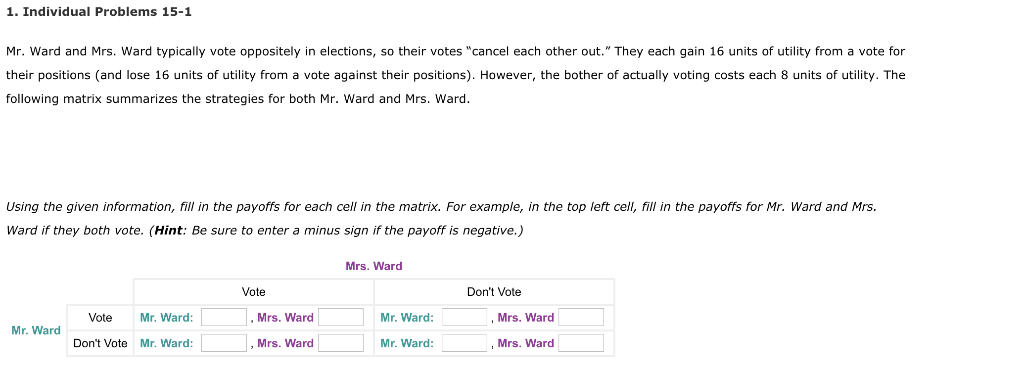Every year, management and labor renegotiate a new employment contract by sending their proposals to an arbitrator, who chooses the best proposal (effectively giving one side or the other $5 million). Each side can choose to hire, or not hire, an expensive labor lawyer (at a cost of $200,000) who is effective at preparing the proposal in the best light. If neither hires a lawyer or if both hire lawyers, each side can expect to win about half the time. If only one side hires a lawyer, it can expect to win nine tenths, or 0.9, of the time. Use the given information to fill in the expected payoff, in dollars, for each cell in the matrix. (Hint: To find the expected payoff, multiply the probability of winning by the dollar amount of the payoff. Be sure to account for lawyer costs, which are incurred with certainty if a lawyer is hired.) Management (M) No Lawyer Lawyer No Lawyer L: $ , M: $ L: $ Labor (L) Lawyer L: $ M: $ L: $ The Nash equilibrium for this game is for Management to a lawyer, and for Labor to a lawyer. M: $ M: $
Every year, management and labor renegotiate a new employment contract by sending their proposals to an arbitrator, who chooses the best proposal (effectively giving one side or the other $5 million). Each side can choose to hire, or not hire, an expensive labor lawyer (at a cost of $200,000) who is effective at preparing the proposal in the best light. If neither hires a lawyer or if both hire lawyers, each side can expect to win about half the time. If only one side hires a lawyer, it can expect to win nine tenths, or 0.9, of the time. Use the given information to fill in the expected payoff, in dollars, for each cell in the matrix. (Hint: To find the expected payoff, multiply the probability of winning by the dollar amount of the payoff. Be sure to account for lawyer costs, which are incurred with certainty if a lawyer is hired.) Management (M) No Lawyer Lawyer No Lawyer L: $ , M: $ L: $ Labor (L) Lawyer L: $ M: $ L: $ The Nash equilibrium for this game is for Management to a lawyer, and for Labor to a lawyer. M: $ M: $
MATLAB: An Introduction with Applications
6th Edition
ISBN:9781119256830
Author:Amos Gilat
Publisher:Amos Gilat
Chapter1: Starting With Matlab
Section: Chapter Questions
Problem 1P
Related questions
Question

Transcribed Image Text:5. Individual Problems 15-5
Every year, management and labor renegotiate a new employment contract by sending their proposals to an arbitrator, who chooses the best proposal
(effectively giving one side or the other $5 million). Each side can choose to hire, or not hire, an expensive labor lawyer (at a cost of $200,000) who is
effective at preparing the proposal in the best light. If neither hires a lawyer or if both hire lawyers, each side can expect to win about half the time. If
only one side hires a lawyer, it can expect to win nine tenths, or 0.9, of the time.
Use the given information to fill in the expected payoff, in dollars, for each cell in the matrix. (Hint: To find the expected payoff, multiply the
probability of winning by the dollar amount of the payoff. Be sure to account for lawyer costs, which are incurred with certainty if a lawyer is hired.)
Management (M)
No Lawyer
Lawyer
No Lawyer L: $
M: $
L: $
Labor (L)
Lawyer
L: $
, M: $
L: $
The Nash equilibrium for this game is for Management to
a lawyer, and for Labor to
a lawyer.
M: $
, M: s

Transcribed Image Text:1. Individual Problems 15-1
Mr. Ward and Mrs. Ward typically vote oppositely in elections, so their votes "cancel each other out." They each gain 16 units of utility from a vote for
their positions (and lose 16 units of utility from a vote against their positions). However, the bother of actually voting costs each 8 units of utility. The
following matrix summarizes the strategies for both Mr. Ward and Mrs. Ward.
Using the given information, fill in the payoffs for each cell in the matrix. For example, in the top left cell, fill in the payoffs for Mr. Ward and Mrs.
Ward if they both vote. (Hint: Be sure to enter minus sign if the payoff is negative.)
Mrs. Ward
Don't Vote
Vote
,Mrs. Ward
Vote Mr. Ward:
Mr. Ward
Mr. Ward:
Mrs. Ward
Don't Vote
Mr. Ward:
Mr. Ward:
Mrs. Ward
Mrs. Ward
Expert Solution
This question has been solved!
Explore an expertly crafted, step-by-step solution for a thorough understanding of key concepts.
This is a popular solution!
Trending now
This is a popular solution!
Step by step
Solved in 3 steps with 1 images

Recommended textbooks for you

MATLAB: An Introduction with Applications
Statistics
ISBN:
9781119256830
Author:
Amos Gilat
Publisher:
John Wiley & Sons Inc

Probability and Statistics for Engineering and th…
Statistics
ISBN:
9781305251809
Author:
Jay L. Devore
Publisher:
Cengage Learning

Statistics for The Behavioral Sciences (MindTap C…
Statistics
ISBN:
9781305504912
Author:
Frederick J Gravetter, Larry B. Wallnau
Publisher:
Cengage Learning

MATLAB: An Introduction with Applications
Statistics
ISBN:
9781119256830
Author:
Amos Gilat
Publisher:
John Wiley & Sons Inc

Probability and Statistics for Engineering and th…
Statistics
ISBN:
9781305251809
Author:
Jay L. Devore
Publisher:
Cengage Learning

Statistics for The Behavioral Sciences (MindTap C…
Statistics
ISBN:
9781305504912
Author:
Frederick J Gravetter, Larry B. Wallnau
Publisher:
Cengage Learning

Elementary Statistics: Picturing the World (7th E…
Statistics
ISBN:
9780134683416
Author:
Ron Larson, Betsy Farber
Publisher:
PEARSON

The Basic Practice of Statistics
Statistics
ISBN:
9781319042578
Author:
David S. Moore, William I. Notz, Michael A. Fligner
Publisher:
W. H. Freeman

Introduction to the Practice of Statistics
Statistics
ISBN:
9781319013387
Author:
David S. Moore, George P. McCabe, Bruce A. Craig
Publisher:
W. H. Freeman